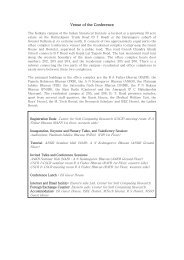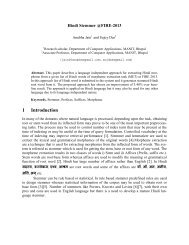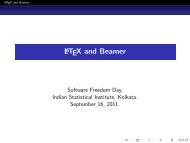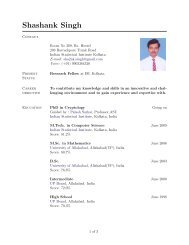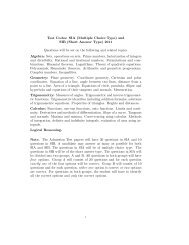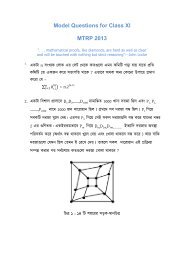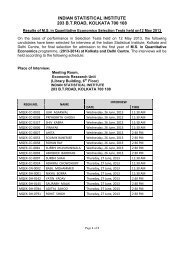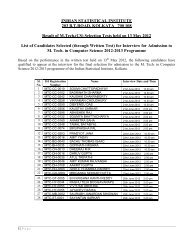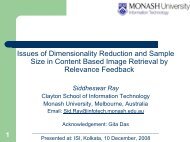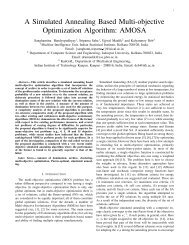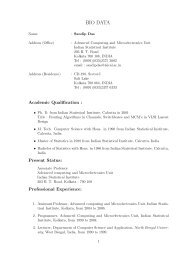Rule-based Stemmers for Bengali and Hindi - Indian Statistical ...
Rule-based Stemmers for Bengali and Hindi - Indian Statistical ...
Rule-based Stemmers for Bengali and Hindi - Indian Statistical ...
You also want an ePaper? Increase the reach of your titles
YUMPU automatically turns print PDFs into web optimized ePapers that Google loves.
DCU@FIRE-2012: <strong>Rule</strong>-<strong>based</strong> <strong>Stemmers</strong> <strong>for</strong><strong>Bengali</strong> <strong>and</strong> <strong>Hindi</strong>Debasis Ganguly, Johannes Leveling, <strong>and</strong> Gareth J. F. JonesCNGL, School of Computing, Dublin City University, Dublin 9, Irel<strong>and</strong>{dganguly, jleveling, gjones}@computing.dcu.ieAbstract. For the participation of Dublin City University (DCU) in theFIRE-2012 Morpheme Extraction Task (MET), we investigated a rule<strong>based</strong> stemming approaches <strong>for</strong> <strong>Bengali</strong> <strong>and</strong> <strong>Hindi</strong> IR. The MET task itselfis an attempt to obtain a fair <strong>and</strong> direct comparison between variousstemming approaches measured by comparing the retrieval effectivenessobtained by each on the same dataset. Linguistic knowledge was usedto manually craft the rules <strong>for</strong> removing the commonly occurring pluralsuffixes <strong>for</strong> <strong>Hindi</strong> <strong>and</strong> <strong>Bengali</strong>. Additionally, rules <strong>for</strong> removing classifiers<strong>and</strong> case markers in <strong>Bengali</strong> were also <strong>for</strong>mulated. Our rule-<strong>based</strong>stemming approaches produced the best <strong>and</strong> the second-best retrievaleffectiveness <strong>for</strong> <strong>Hindi</strong> <strong>and</strong> <strong>Bengali</strong> datasets respectively.1 IntroductionStemming is an important preprocessing step in in<strong>for</strong>mation retrieval (IR), whichinvolves normalizing inflected words, essentially representing the same concept,to an equivalent representation in the index (called the stem). For example, anideal stemmer should normalize the words friend, friends, friendly, <strong>and</strong> friendshipto the stem friend.Stemming approaches can broadly be classified into two different categories:i) rule-<strong>based</strong>, where an inflected word is typically normalized by successivelyremoving the suffixes by applying a set of rules, e.g. the suffixes s, ly, <strong>and</strong> shipcan be removed from the inflections to obtain the stem friend; ii) corpus-<strong>based</strong>,where words are grouped into an equivalent set representing the same concept,by utilizing several corpus-wide statistical features such as co-occurrence or individualword-<strong>based</strong> features such as edit-distance etc.The advantages of a rule-<strong>based</strong> stemmer over a corpus <strong>based</strong> approach are:i) it is much faster because it does not require any pre-processing step onthe indexed documents; ii) the corpus <strong>based</strong> methods are error prone due tounder-training on a corpus not large enough <strong>for</strong> reliable statistical training; <strong>and</strong>iii) highly frequent proper nouns might lead to stemming errors.A disadvantage is that the stemming rules may have to be created manually<strong>and</strong> <strong>for</strong> each language. Another limitation of a rule-<strong>based</strong> stemming approachis that <strong>for</strong> some inflected words, it might not be possible to <strong>for</strong>mulate a genericenough rule <strong>for</strong> suffix removal. For example, while it is easy to remove the suffix
ship to get the stem friend, a simple suffix removal does not suffice to normalizethe word enmity to enemy. Exceptions thus need to be <strong>for</strong>mulated <strong>for</strong> a set ofwords. Despite the limitations, the most widely used stemmers in English arethe rule-<strong>based</strong> ones viz. Porter stemmer [1] <strong>and</strong> the Lovins stemmer [2].For <strong>Indian</strong> languages, which are more inflecting in nature than English, themost commonly used stemming approaches have been the corpus-<strong>based</strong> one [3,4]. The only reported work involving rule-<strong>based</strong> stemming <strong>for</strong> <strong>Bengali</strong> is [5].However, there has not been any reported work seeking direct comparison betweenthe stemming approaches i.e. applying the different stemming approacheson the same document collection <strong>and</strong> query set, <strong>and</strong> comparing the retrieval effectivenessobtained by each. The Morpheme Extraction Task (MET) inceptedin FIRE-2012 is an attempt to achieve a fair <strong>and</strong> direct comparison betweendifferent stemming approaches.In this paper, we describe our participating systems in the MET-2012. Wedeveloped two rule-<strong>based</strong> stemmers <strong>for</strong> <strong>Bengali</strong> <strong>and</strong> <strong>Hindi</strong>. The rest of the paperis organized as follows. Section 2 describes the related work which is followedby Sections 3 <strong>and</strong> 4 describing the rules <strong>and</strong> how are they applied <strong>for</strong> <strong>Bengali</strong><strong>and</strong> <strong>Hindi</strong>. Section 5 evaluates the proposed stemmers by presenting the officialresults. Finally, Section 6 concludes the paper with directions <strong>for</strong> future work.2 Related WorkStemming approaches can be classified into different categories, e.g. by the resultsproduced by the stemmer (light stemming [6] vs. aggressive stemming [2]) or bythe resources used (corpus-<strong>based</strong> [7] vs. dictionary-<strong>based</strong> [8]).The most widely used stemming approach <strong>for</strong> English is the rule-<strong>based</strong> Porterstemmer [1], which successively applies rules to trans<strong>for</strong>m a word <strong>for</strong>m into itsbase <strong>for</strong>m. The successive removal of affixes means that words with a recursivemorphological structure are reduced to their base <strong>for</strong>m, e.g. words such ashopelessness may be reduced to hope by removing the suffixes ness <strong>and</strong> less.Light stemming focuses on removing only a few but the most frequent suffixesfrom word <strong>for</strong>ms. Recently, light stemming has been researched as a less aggressivemeans to reduce words to their root <strong>for</strong>m. For English, the s-stemmer whichremoves only the -s, -es, <strong>and</strong> -ies suffixes from words <strong>and</strong> other light stemmingapproaches have been proposed (see, <strong>for</strong> example, [9] <strong>and</strong> [10]).YASS is a clustering-<strong>based</strong> suffix stripper which has been applied to documentsin English, French, <strong>and</strong> <strong>Bengali</strong> [3]. YASS identifies clusters of equivalenceclasses <strong>for</strong> words by calculating distance measures between strings. This stemmerrelies on multiple word lists which have to be extracted from documents,i.e. all words starting with the same character have to be collected in the sameword list in a scan over all documents.Xu <strong>and</strong> Croft [7] use a combination of aggressive suffix removal with cooccurrencein<strong>for</strong>mation from small text windows to identify stemming classes.This technique is corpus-<strong>based</strong> <strong>and</strong> requires little knowledge about the document
language. The original stemmer was developed <strong>for</strong> a Spanish document collection[7] <strong>and</strong> shows an increase in recall <strong>for</strong> Spanish.Goldsmith [11] identified suffixes employing a minimum description length(MDL) approach. MDL reflects the heuristic that words should be split into arelatively common root part <strong>and</strong> a common suffix part. Every instance of a word(token) must be split at the same breakpoint, <strong>and</strong> the breakpoints are selectedso that the number of bits <strong>for</strong> encoding documents is minimal.Oard, Levow et al. [12] apply the Linguistica tool by Goldsmith [11] tocreate a statistical stemmer. Suffix frequencies are computed <strong>for</strong> a subset of500,000 words in a document collection. The frequencies of suffixes up to alength of 4 were adjusted by subtracting the frequency of subsumed suffixes.Single-character suffixes were sorted by the ratio between their final positionlikelihood <strong>and</strong> their unconditional likelihood. Suffixes were sorted in decreasingorder of frequency, choosing a cutoff value where the second derivative of thefrequency vs. rank was maximized.3 <strong>Bengali</strong> StemmerWe start this section with a brief introduction to the word inflection grammar of<strong>Bengali</strong>, which is then used to <strong>for</strong>mulate the explicit rules <strong>and</strong> the methodologydevised to apply them in sequence.<strong>Bengali</strong> is an Indo-Aryan language spoken by more than 200 million people inBangladesh <strong>and</strong> the <strong>Indian</strong> state of West Bengal. <strong>Bengali</strong> is a highly inflectionallanguage with frequent compound suffixes which makes it necessary to applyrules in steps. Morphogical affixing in <strong>Bengali</strong> can be categorized into: a) Inflectional,where the part-of-speech of the inflected word remains unchanged; <strong>and</strong>b) Derivational, where the part-of-speech of the inflected word changes.Since nouns, typically due to their higher Inverse Document Frequency (idf )values, are more important in IR than other parts-of-speech [13], <strong>for</strong> inflectionalmorphology we restrict our investigation to nouns only. Bhattacharya et al. [14]show that noun inflections can grouped into:i) Title markers: These are the titles such as দবী (“Mrs.”), বাবু (sir) etc. whichare added as suffixes to proper nouns.ii) Classifier: Used to denote plurality <strong>and</strong> specificity of a noun e.g. a root wordছিব (picture) may be inflected as ছিবেলা (pictures) or ছিবটা (the picture). Aclassifier can also indicate the gender of a noun e.g.ছা (student) may beinflected to ছাী to particularly denote a female student.iii) Case marker: Used to denote possessive or accusative relations with otherwords. The possessive case marker <strong>for</strong> English is the apostrophe character.English does not use accusative markers. An example of an possessivemarker is পিরবােরর where the suffix ◌র is added to the root <strong>for</strong>m পিরবার (family)to mean “family’s”.iv) Emphasizer: These markers are used to emphasize the current word e.g.ছিবmay be inflected to ছিবই to denote an equivalent of “only a picture” in English.
All of the above suffix types can appear in a word but only in the specified ordere.g.ছিবেলােকও, where েলা (a plurality classifier), ক (an accusative marker) <strong>and</strong> ও(an emphasizer) have been used to derive “’also those pictures” from the rootword ছিব. With reference to the above example, we see that <strong>for</strong> English languageIR “also” <strong>and</strong> “those” can be easily removed since these are stopwords <strong>and</strong> thetrailing “s” which is the plural classifier, can be removed by a simple rule. But in<strong>Bengali</strong> it is difficult since an English phrase can map to a single word <strong>and</strong> notnormalizing this word to the base <strong>for</strong>m can result in a poor retrieval per<strong>for</strong>mance.Title markers if present come be<strong>for</strong>e the case markers.Algorithm 1 shows the algorithm to remove the suffixes <strong>for</strong> <strong>Bengali</strong> <strong>and</strong>Table 1 illustrates a particular case in the control flow of the <strong>for</strong>mer. To h<strong>and</strong>lecompound suffixes rules are applied in a series of steps.Algorithm 1 <strong>Bengali</strong> Suffix Stripper(w)1: len ← len[w]2: {Drop the emphasizers}3: if w[len-1] = ও or w[len-1] = ই then4: len ← len-1;5: end if6: {Drop the classifiers <strong>and</strong> case markers}7: x = {তা, টা, িট, টু, ক, র, ◌র, দর ভােব}8: while ∃ x: w=w’x do9: w ← w’; len ← len[w’];10: end while11: {Drop title markers}12: x = {কারী, শীল, দবী, বাবু, ভাই}13: while ∃ x: w=w’x do14: w ← w’; len ← len[w’];15: end while16: {Drop the plural suffixes}17: x = {রা, েলা, িল, েলােত, িলেত}18: if ∃ x: w=w’x then19: w ← w’; len ← len[w’];20: end if21: {Drop the derivational suffixes}22: V = {<strong>Bengali</strong> Vowels} ∪ {<strong>Bengali</strong> Matras}∪ {য়}23: while w[len-1] ∈ V do24: len ← len-125: end while26: if len>2 then27: w ← w[0. . .len-1]28: end if29: return w
Table 1: <strong>Rule</strong>s <strong>for</strong> simple suffixes with <strong>Bengali</strong> examples.Lines Suffix type <strong>Bengali</strong> notation ITRANS notation4 Emphasizer আিধকই → আিধক Adhikya[i] → Adhikya4, 19 Emphasizer <strong>and</strong> plural মীরাও → মী mantrI[rAo] → mantrIclassifier9 Specific classifier মুেখাশটা → মুেখাশ mukhosh[TA] → mukhosh9 Possessive case marker ভারেতর → ভারত bhArat[er] → bhArat9 Plural accusative case িশীেদর → িশী shilpI[der] → shilpImarker9, 9 Specific classifier <strong>and</strong> Possessiveিনয়াটার → িনয়া duniyA[TAr] → duniyAcase marker14 Derivational িতীশীল → িতী sthitI[shIl] → sthitI14 Title marker কনােদবী → কনা karunA[debI] → karunA9, 2 Plural accusative case ভারতীয়েদর → ভারতীয় bhAratiya[der] → bhAratiyamarker <strong>and</strong> derivational4 <strong>Hindi</strong> StemmerIn <strong>Hindi</strong>, the inflections are less complex than <strong>Bengali</strong> <strong>and</strong> hence can be addressedby a smaller number of rules. For instance, the accusative markers <strong>and</strong>emphasizers in <strong>Hindi</strong> instead of <strong>for</strong>ming inflections as in <strong>Bengali</strong>, appear as separatewords. An example in <strong>Hindi</strong> is “भारतीय को” (to an <strong>Indian</strong>) instead of“ভারতীয়েক” as in <strong>Bengali</strong>.In fact, there are only four cases of noun inflections <strong>for</strong> <strong>Hindi</strong>. Table 2 summarisesthese with examples. To remove the inflections in <strong>Hindi</strong>, a very simplerule similar to Step 21 of Algorithm 1 was employed. To be more precise, wego on removing <strong>Hindi</strong> vowels, matras, anusvara <strong>and</strong> य from the rightmost partof a word until the first consonant is encountered. The algorithm is outlined inAlgorithm 2. It is easy to see that the application of Algorithm 2 on the wordलड़िकयां (girls) yields the stem लड़की (girl).Table 2: Noun inflections in <strong>Hindi</strong>RootInflected <strong>for</strong>mWord English translation Word English translationलड़का boy लड़के boys (direct plural)लड़का boy लड़कों boys (indirect plural)लड़की girl लड़िकयां girls (direct plural)लड़की girl लड़िकयों girls (indirect plural)
Algorithm 2 <strong>Hindi</strong> Suffix Stripper(w)1: len ← len[w]2: {Drop the derivational suffixes}3: V = {<strong>Hindi</strong> Vowels} ∪ {<strong>Hindi</strong> Matras} ∪ {य, ँ}4: while w[len-1] ∈ V do5: len ← len-16: end while7: return w5 EvaluationAlgorithms 1 <strong>and</strong> 2 were implemented in the C programming language as st<strong>and</strong>aloneapplications. The complete source code was submitted to the MET organizers,who compiled the code to build the executables at their end. Eachstemmer executable takes as input a list of words, which is the set of uniquewords indexed by Terrier 1 <strong>for</strong> the FIRE-2011 document collection in a particularlanguage. The stemmer executable then generates a bi-column file, eachline of which comprises of the original word tab separated by its stemmed <strong>for</strong>m.The stemmed <strong>for</strong>ms were then used to create a separate index <strong>and</strong> run retrievalagainst it.The official results are shown in Table 3. Our runs are named by “DCU”.Five official runs were submmitted <strong>for</strong> the <strong>Bengali</strong> task, whereas only two weresubmitted <strong>for</strong> <strong>Hindi</strong>. It can be seen that our <strong>Bengali</strong> rule-<strong>based</strong> stemmer achievesa per<strong>for</strong>mance improvement of 20.69% over the baseline (no stemming). Theimprovement obtained over the baseline with our rule-<strong>based</strong> <strong>Hindi</strong> is less (5.03%).The most likely reason of getting more improvement <strong>for</strong> <strong>Bengali</strong> is that <strong>Bengali</strong>being a language with more complex morphology than <strong>Hindi</strong>, offers a largerscope of improvement by the stemming process.Table 3: Official results of the MET-2012 task.Team Language MAPBaseline <strong>Bengali</strong> 0.2740JU <strong>Bengali</strong> 0.3307 (20.69%)DCU <strong>Bengali</strong> 0.3300 (20.44%)IIT-KGP <strong>Bengali</strong> 0.3225 (17.70%)CVPR-Team1 <strong>Bengali</strong> 0.3159 (15.29%)ISM <strong>Bengali</strong> 0.3103 (13.25%)Baseline <strong>Hindi</strong> 0.2821DCU <strong>Hindi</strong> 0.2963 (5.03%)ISM <strong>Hindi</strong> 0.2793 (-0.99%)1 http://terrier.org/
6 Conclusions <strong>and</strong> Future WorkOur rule-<strong>based</strong> stemmers <strong>for</strong> <strong>Hindi</strong> <strong>and</strong> <strong>Bengali</strong> yielded the best <strong>and</strong> secondbest per<strong>for</strong>mance gains in retrieval effectiveness, respectively. Future work willinvolve extending the rules <strong>and</strong> adding appropriate exceptions.AcknowledgmentsThis research is supported by the Science Foundation Irel<strong>and</strong> (Grant 07/CE/I1142)as part of the Centre <strong>for</strong> Next Generation Localisation (CNGL) project.References1. Porter, M.F.: An algorithm <strong>for</strong> suffix stripping. Program 14(3) (1980) 130–1372. Lovins, J.B.: Development of a stemming algorithm. Mechanical translation <strong>and</strong>computation 11(1-2) (1968) 22–313. Majumder, P., Mitra, M., Parui, S.K., Kole, G., Mitra, P., Datta, K.: YASS: Yetanother suffix stripper. ACM Trans. Inf. Syst. 25(4) (2007)4. Paik, J.H., Pal, D., Parui, S.K.: A novel corpus-<strong>based</strong> stemming algorithm usingco-occurrence statistics. In: Proceedings of the SIGIR ’11. (2011) 863–8725. Leveling, J., Ganguly, D., Jones, G.J.F.: DCU@FIRE2010: Term conflation, blindrelevance feedback, <strong>and</strong> cross-language IR with manual <strong>and</strong> automatic query translation.In: Second Workshop of the Forum <strong>for</strong> In<strong>for</strong>mation Retrieval Evaluation(FIRE 2010), Working Notes. (2010) 39–446. Savoy, J.: A stemming procedure <strong>and</strong> stopword list <strong>for</strong> general French corpora.Journal of the American Society <strong>for</strong> In<strong>for</strong>mation Science 50(10) (1999) 944–9527. Xu, J., Croft, B.: Corpus-<strong>based</strong> stemming using co-occurence of word variants.ACM transactions on in<strong>for</strong>mation systems 16(1) (1998) 61–818. Krovetz, R.: Viewing morphology as an inference process. In: SIGIR, ACM (1993)191–2029. Harman, D.: How effective is suffixing? Journal of the American Society <strong>for</strong>In<strong>for</strong>mation Science 42(1) (1991) 7–1510. Savoy, J.: Light stemming approaches <strong>for</strong> the French, Portuguese, German <strong>and</strong>Hungarian languages. In: Proceedings of the 2006 ACM Symposium on AppliedComputing (SAC), Dijon, France, April 23–27, 2006, ACM (2006) 1031–103511. Goldsmith, J.: Unsupervised learning of the morphology of a natural language.Computational Linguistics 27 (2001) 153–19812. Oard, D.W., Levow, G.A., Cabezas, C.I.: CLEF experiments at Maryl<strong>and</strong>: <strong>Statistical</strong>stemming <strong>and</strong> backoff translation. In: Cross-Language In<strong>for</strong>mation Retrieval<strong>and</strong> Evaluation, Workshop of Cross-Language Evaluation Forum, CLEF 2000, Lisbon,Portugal, September 21–22, 2000, Revised Papers. Volume 2069 of LectureNotes in Computer Science (LNCS)., Springer (2001)13. Xu, J., Croft, W.B.: Improving the effectiveness of in<strong>for</strong>mational retrieval withLocal Context Analysis. ACM Transactions on in<strong>for</strong>mation systems 18 (2000)79–11214. Bhattacharya, S., Choudhury, M., Sarkar, S., Basu, A.: Inflectional morphologysynthesis <strong>for</strong> bengali noun, pronoun <strong>and</strong> verb systems. In: In Proceedings of thenational conference on computer processing of Bangla (NCCPB. (2005) 34–43



